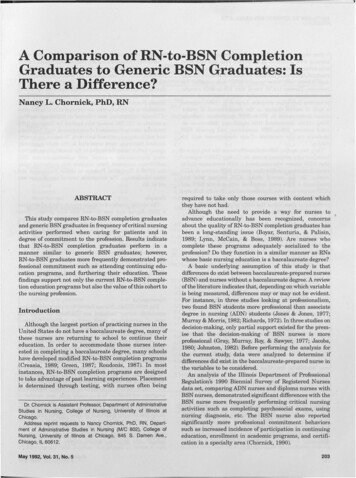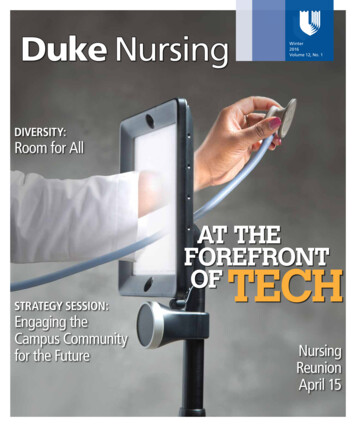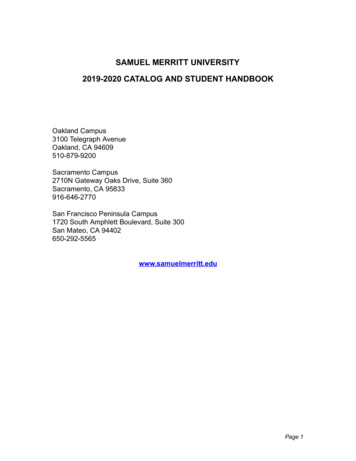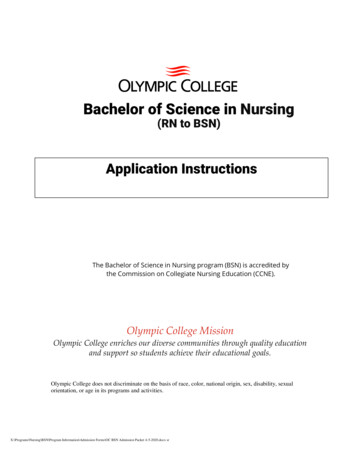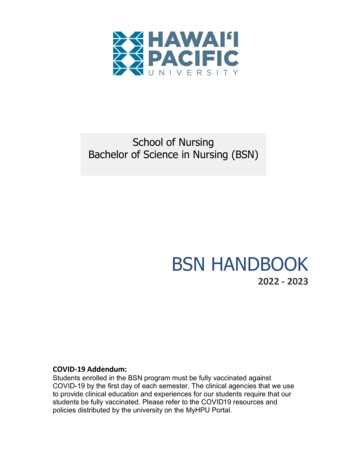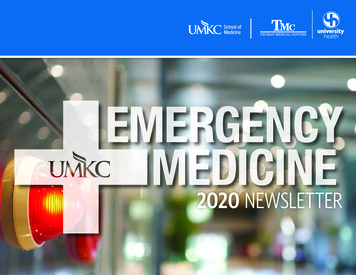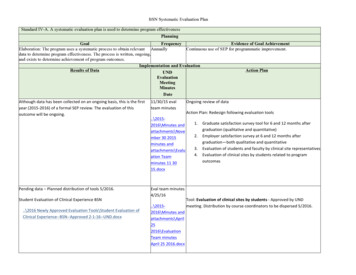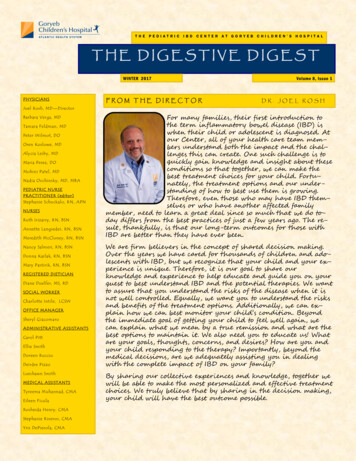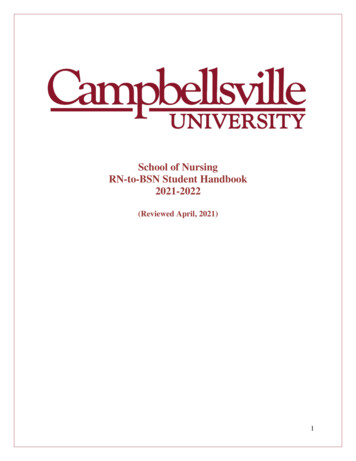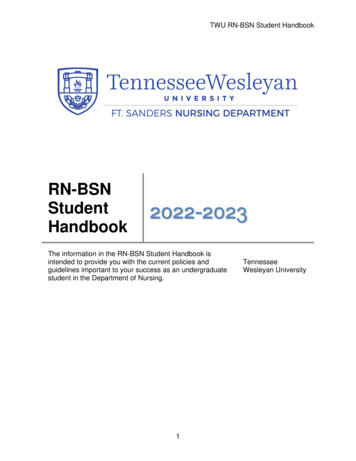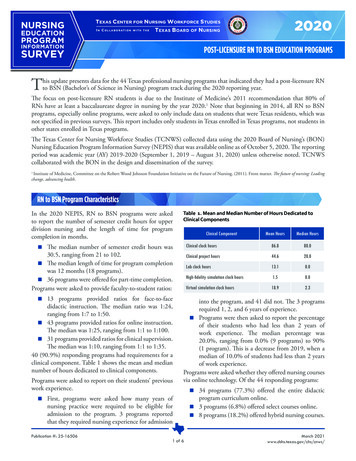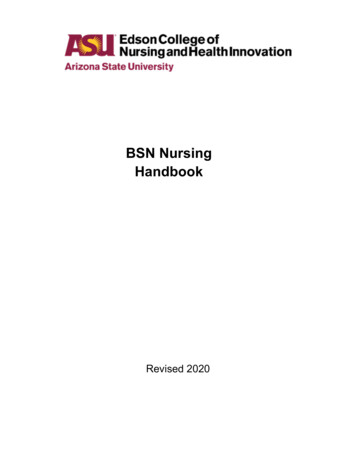
Transcription
BSN NursingHandbookRevised 2020
Table of ContentsINTRODUCTION . 4EDSON COLLEGE OF NURSING AND HEALTH INNOVATION OVERVIEW . 6ACCREDITATION . 7PROGRAM FOUNDATION . 7CONCEPTUAL FRAMEWORK . 8SECTION 2: BACCALAUREATE PROGRAMS. 10ORGANIZATION . 10PRELICENSURE PROGRAM COMPLETION OUTCOMES . 11BACCALAUREATE NURSING PROGRAMS . 12ADVANCEMENT PATHWAYS . 12CONCURRENT ENROLLMENT PROGRAM (CEP) . 20RN TO BSN PROGRAM . 20UNIVERSITY POLICIES . 22COURSE EXPIRATION . 223GRADING SCALE . 23PRELICENSURE NURSING ATTENDANCE REQUIREMENTS FOR CLINCAL AND SIMULATEDLEARNING EXPERIENCES . 24PROGRAM PROGRESSION . 275PROBATION. 27DISQUALIFICATION . 27PROGRAM COMPLETION . 27NURSING LICENSURE FOR PRELICENSURE NURSING PROGRAM STUDENTS . 28RN LICENSURE FOR STUDENTS ENROLLED IN THE RN to BSN AND CEP PROGRAMS . 299LEGAL LIMITATIONS FOR NURSE LICENSURE OR REASONS FOR DENIAL OF APPLICATIONBY THE ARIZONA STATE BOARD OF NURSING . 29UNIVERSITY COMMENCEMENT . 29EDSON COLLEGE CONVOCATION . 29SECTION 3: STUDENT SUPPORT SERVICES . 30ACADEMIC ADVISEMENT – STUDENT ACADEMIC SERVICES . 30DEGREE AUDIT REPORTING SYSTEM (DARS) . 30CHANGE OF NAME AND ADDRESS . 31FINANCIAL AID . 31STUDENT SUCCESS CENTERS . 31STUDENT ACCESSIBILITY AND INCLUSIVE LEARNING SERVICES (SAILS) . 312
SECTION 4: SPECIAL PROGRAMS . 32BARRETT HONORS PROGRAM . 32SECTION 5: PROFESSIONAL BEHAVIOR AND EXPECTATIONS . 33CLINICAL DRESS CODE. 33SUBSTANCE-FREE STATUS: UNIVERSITY AND COLLEGE PROTOCOLS & PROCEDURES . 35UNRESTRICTED LEVEL ONE FINGERPRINT CARD . 355REPORTING MISDEMEANOR AND FELONY CHARGES . 36ETHICAL BEHAVIOR. 36REPORTING UNUSUAL OCCURRENCES . 38ADHERENCE TO CLINICAL AGENCY REQUIREMENTS . 39SELF-RESPONSIBILITY . 39STANDARD STUDENT SIGNATURE . 39GENERAL DESCRIPTION OF REQUIRED NURSING PRACTICE FOR STUDENTS . 39HEALTH AND SAFETY STANDARDS . 400STATEMENT OF HEALTH CLEARANCE . 400CASTLEBRANCH . 411MY CLINICAL EXCHANGE. 444LATEX SENSITIVITY AND/OR ALLERGY . 444INFECTION CONTROL PROTOCOLS & PROCEDURES . 455Appendix A CONSENT FOR SCREENING AND TRANSPORTATION FORM A . 477Appendix B CONSENT FOR SCREENING AND TRANSPORTATION FORM B . 48Appendix C SAFE PRACTICE IN CLINICAL/LABORATORY SETTINGS . 49Appendix D STUDENTS’ PRACTICING SPECIFIC SKILLS ON OTHER STUDENTS . 522Appendix E SKILLS PRACTICE BAG. 555Appendix F ACADEMIC AND PROFESSIONAL INTEGRITY POLICY . 566Appendix G STUDENT INTEGRITY PLEDGE . 60Appendix H GRIEVANCE PROTOCOL AND PROCEDURE . 611Appendix I UNUSUAL OCCURRENCE PROTOCOL & PROCEDURE . 71Appendix J IMMUNIZATIONS . 75Appendix K BLOODBORNE PATHOGENS. 79Appendix L STATEMENT OF DISCLOSURE . 811Appendix M ONE TIME DEFERMENT OF ADVANCEMENT. 8123
INTRODUCTIONArizona State University Edson College of Nursing and Health Innovation offers this handbookto students admitted to the Bachelor of Science in Nursing (BSN) program. The purpose of thehandbook is to inform students of the guidelines, procedures, academic expectations, studentrequirements, and student resources of the Edson College of Nursing and Health Innovation.This handbook serves as a supplement to the Arizona State University General Catalog.Students are expected to review the handbook on the first day of classes for every fall, spring,and summer terms.4
ADDRESSES AND TELEPHONE NUMBERSDowntown CampusAddress:Edson College of Nursing and Health InnovationArizona State UniversityMail Code 3020550 N. 3rd StreetPhoenix, AZ 85004-0698602-496-2644; Fax: 602-496-0886Student Services:Edson College of Nursing and Health InnovationMail Code 8220502 E. Monroe St., Ste. C 250Phoenix, AZ 85004-4431602-496-0888; Fax: 602-496-0705Web Sitehttps://nursingandhealth.asu.edu/Mayo Clinic CampusAddress:Edson College of Nursing and Health Innovation at Mayo campus5777 E. Mayo BoulevardSupport Services Building, Clinical and Patient EducationPhoenix, AZ 85054Advisement Office:602-496-0888; Fax: 602-496-0705Web Sitehttps://mayo.asu.edu/5
EDSON COLLEGE OF NURSING AND HEALTH INNOVATION OVERVIEWThe Edson College of Nursing and Health Innovation is distinguished as a model forexcellence and inspiration in nursing and interprofessional practice, education, and research toadvance knowledge and innovative practice models, and new solutions to optimize the healthand well-being of our diverse local, national and global communities. Learn more about thehistory of the college.Mission & GoalsDeliver excellent, innovative, nationally-recognized nursing and interprofessionalprograms that are accessible, inclusive, and learner-centered Distinguish our academic programs through (1) impactful curricular development thatreflects national health initiatives; (2) recruitment and retention of world class faculty; and(3) achievements of students and alumni. Broaden diverse student access, enrollment and retention in our academic communitythrough (1) tailored marketing; (2) financial support; (3) student support services; and (4)state of the art learning experiences.Build national reputation in innovative nursing and health related programs thatsignificantly impact individuals and communities Create or refine and disseminate teaching strategies that are student-centered, adaptive,and interactive. Develop program-specific criteria that advance academic excellence leading to nationalrecognition of the Edson College of Nursing and Health Innovation. Establish collaborative networks to foster innovative programs that impact local, national,and global health.Establish ASU as a global center for interdisciplinary research, discovery anddevelopment by 2020 Conduct innovative science and participate in and lead interdisciplinary research teams. Contribute to the global community of scholars to inform the scientific knowledge base andinfluence health outcomes. Provide professional and research mentorship to develop the next generation of scientistswho positively affect health outcomes.Enhance our local impact and social embeddedness Increase student and faculty collaboration within the community that is reciprocal, beneficialand sustainable to improve health outcomes. Engage community members and leaders in designing relevant health related activities andprograms responsive to the needs of diverse populations.Learn more: https://nursingandhealth.asu.edu/about6
SECTION 1: GENERAL INFORMATIONACCREDITATIONThe baccalaureate degree in nursing/master’s degree in nursing/and Doctor of Nursing Practice at theArizona State University Edson College of Nursing and Health Innovation is accredited by theCommission on Collegiate Nursing Education (http://www.aacn.nche.edu/ccne-accreditation ) throughJune 30, 2024. All programs are also approved by the Arizona State Board of Nursing.PROGRAM FOUNDATIONPHILOSOPHY and PURPOSEThe college embraces the philosophy and purpose of Arizona State University, which is committed tothe exchange of knowledge and the pursuit of wisdom within an atmosphere of intellectual honesty andfreedom. Arizona State University and the Edson College of Nursing and Health Innovation seek tofoster excellence in scholarship, research, service, and practice.The educational programs of the college are dedicated to providing students with the opportunity toacquire the requisite knowledge, skills, attitudes, and values to become professional nurses and nurseleaders who are capable practitioners prepared to respond to changing healthcare needs and patternsof healthcare delivery. The faculty believes that the central concepts of nursing education and nursingpractice are client, environment, health, and nursing and adhere to the following definitions andassumptions about these concepts:ClientThe client is considered to be an individual, family, population group, or community with identifiablehealth and illness behaviors. The client is conceptualized from a holistic and developmentalperspective. Clients are engaged in continuous, dynamic interaction with their environments as bothincreases in complexity and diversity. Clients have a right to determine and participate actively in thepursuit of their own health goals. Clients should have the opportunity to achieve and maintain thehighest possible level of health.EnvironmentThe environment includes the internal and external contexts of individuals, families, population groups,and communities. The internal environment may include physiological and psychological variables aswell as the client’s unique interpretation of interpersonal, spiritual, social, and cultural factors.The external environment consists of the physical, biological, socio-psychological, and chemical factorsthat may impinge upon clients and their health. In addition, the external environment can include thecollective social, economic, political, cultural, and technological values and conditions that influenceclients, their health behaviors, and goals.HealthHealth is a dynamic process that reflects the interaction between clients and their internal and externalenvironments. Optimal wellness is the highest state of health and is the ideal toward which the clientmoves at varying rates and in various ways. Such wellness results from successful, positive interaction7
between client and environment. Illness is a state of health in which negative or unsuccessfulinteraction between the client and environment has occurred. Wellness potential exists in illness,however, and the goal of nursing is to promote and restore wellness.NursingNursing is a humanistic discipline that is both art and science. The raison d’être (reason to be) fornursing is to promote wellness and to care for those clients who are ill. The discipline of nursingencompasses science, humanities, ethics, values, and the heritage of nursing, and is defined by therelationships and interactions among the concepts of client, environment, and health. The aim ofprofessional nursing practice is to enhance the quality of life for clients. Nursing practice is based onan understanding of the interactions of client and environment in relation to health.The educational content of professional nursing incorporates practice and research components of thediscipline in the promotion, maintenance, restoration of wellness, and the care of the sick and dying.Professional nurses use knowledge from nursing and the sciences and humanities as the basis forestablishing and meeting goals of the professional and determining standards for education andpractice. Nurses are responsible and accountable for the quality of practice. Implementing andevaluating healthcare services and policies improve and expand the theoretical and clinical bases ofnursing practice. In the process of practicing professional nursing, collaborative and cooperativerelationships are developed with others concerned with health, healthcare issues, and quality of life.CONCEPTUAL FRAMEWORKThe conceptual framework for the degree programs is derived from the nursing philosophy andprogram completion outcomes of the academic programs. It identifies the necessary supportinglinkages among the four major, multidimensional concepts emphasized within the programs,specifically, client, environment, health, and nursing. The unifying concept is that of interaction. Linkedtogether in interaction, client, environment, health, and nursing are viewed as synergistically acting andreacting together in dynamic, mutually influencing interrelationships.The client includes individuals, families, population groups, and communities. From a nursingperspective, the client is viewed from a developmental and holistic approach. As such, clients havebiophysical, psychological, social, cultural, and spiritual dimensions making up the internalenvironment, all of which interact among themselves and with the external environment to create andinfluence health. Moreover, through this continuous interaction with the environment, life-spandevelopment occurs. Thus, the client’s interaction with the internal and external environments is linkedinextricably with wellness and illness, health behaviors, and goals.Health is a dynamic process that encompasses both wellness and illness. Wellness is the highest stateof health. When illness exists, optimal outcomes for clients may range from restoration of wellness to apeaceful death. Clients have the right and responsibility to participate actively in establishing andpursuing their own health goals. Healthcare exists on a continuum of prevention (health promotion,maintenance, and restoration through rehabilitation and illness prevention).Nursing is an interactive process in which nurses collaborate with clients and other members of thehealthcare disciplines in providing care to clients and in improving nursing and other healthcareservices. The purpose of professional nursing is the promotion, maintenance, and restoration of thehealth of clients through the application of the nursing process. Effective application of the nursingprocess mandates a synthesis of theoretical and empirical knowledge from the sciences and8
humanities with the art and science of nursing. In addition, nursing is accomplished through a numberof roles, specifically, roles of a generalist, specialist, practitioner, educator, manager, and researcher,each requiring differing skills and levels of academic preparation. Common to all these roles, however,are the processes of teaching and learning, leadership, critical thinking and scientific inquiry, decisionmaking, accountability, and responsibility. These processes as well as other concepts, theories, andskills of the generalist role are introduced at the baccalaureate level. Building on the generalist role,specialization occurs at the master’s level and is based on a common core of knowledge as well asadvanced concepts, theories, principles, and research from nursing and other related disciplinesapplied to a specialized area of nursing. Such in-depth preparation in a specialized area of practicepromotes research that expands or extends the scientific basis of the discipline and advances thenurse’s role in a specialized area of nursing practice.9
SECTION 2: BACCALAUREATE PROGRAMSORGANIZATIONPrelicensure Nursing ProgramsTraditional Prelicensure Clinical Nursing Program (Traditional BSN)Accelerated Prelicensure Clinical Nursing Program (Accelerated BSN)Online BSN ProgramsRN to BSN Program (RN-BSN)Concurrent Enrollment Program (CEP)Eastern Arizona College Program (Hybrid CEP)10
PRELICENSURE PROGRAM COMPLETION OUTCOMESUpon completion of the baccalaureate prelicensure clinical nursing programs, the graduate willdemonstrate fluency and facility in the five patterns of knowing in professional nursing practice throughthe ability to:1. Combine theoretical knowledge from the sciences, humanities, and nursing as a foundation forcritical thinking in professional nursing practice and demonstrate a comprehensiveunderstanding of the relationship among client, health, environment, and nursing.2. Design and deliver comprehensive therapeutic nursing care in partnership with individuals,families, groups, and communities, including those clients who are culturally diverse and/orvulnerable and at-risk for health disparities.3. Provide safe, competent, innovative, and effective nursing care utilizing principle-basedcommunication, informatics, technology, psychomotor, teaching, management, and therapeuticskills.4. Generate own professional practice that focuses on health promotion, risk reduction, diseaseprevention, and illness and disease management from a holistic perspective.5. Critically appraise and apply research findings and other evidence to deliver and promoteevidence-based client care and evaluate subsequent outcomes.6. Display behaviors consistent with the values and ethics of professional nursing.7. Display personal and leadership characteristics appropriate for innovative designers, providers,managers, and coordinators of care.8. Display responsibility and accountability for professional nursing practice.9. Collaborate with nurses, other healthcare providers, and clients in the delivery of holistic carethat is responsive to changing needs, sociopolitical, and global environmental factors.10. Analyze current nursing and healthcare services, trends, and identify future healthcare needs toadvocate for the client and the profession.11
BACCALAUREATE NURSING PROGRAMSTraditional Prelicensure Clinical Nursing Program (Traditional BSN)Students may complete the upper-division traditional prelicensure clinical nursing program in a 16month year-round schedule or a 24-month academic-year schedule.Students enrolled in the 16-month year round schedule will begin the clinical nursing program in Mayand graduate the following August. ASU does not provide a separate commencement ceremony forAugust graduates. Students who graduate in August are encouraged to participate in the fallcommencement and convocation ceremonies.Advancement PathwaysStudents earn advancement into the traditional prelicensure clinical nursing program in two ways:through Direct Admission or through the Competitive Application Process. Students who are directlyadmitted into the nursing major must meet specific standards each semester to maintain guaranteedadvancement into the traditional prelicensure clinical nursing program. Remaining spaces, or thosespaces not filled by Direct Admission students, are earned though the Competitive Application Process.Direct AdmissionSome applicants have earned Direct Admission status upon entering ASU as a first-year (freshman)nursing major. These students must meet the Continuing Eligibility Criteria each semester to maintainthis status. If direct admission is retained throughout the advancement process, these students areguaranteed placement into the clinical nursing program. Advancement of qualified Direct Admissionstudents will take place within one year of the semester where all 17 critical courses are completed.Direct Admission students are not guaranteed their first preference. In the event where more DirectAdmission students request placement in a specific cohort than spaces are available, placement will bedetermined by random selection.Continuing Eligibility Criteria is established to create a direct admit cohort. All studentsmust adhere to the following guidelines each semester: Enroll in the courses following the published course sequence on the major map. Full-time enrollment at ASU (at least 12 hours per term; some scholarships require at least 15hours per term).Enroll in the courses following the published course sequence on the major map (taking coursesaccording to term).Courses taken during the required term at institutions other than ASU must have gradesrecorded on the ASU system by the final session C grading deadline per the ASU AcademicCalendar.3.50 minimum semester critical (prerequisite) course GPA in Terms 1-4 (includes /- incomputation)Successful completion of all screening itemsGrades of C or better in critical (prerequisite) coursesAny deviation from the approved major map requires a petition and approval from the academicprogram. Please consult with your advisor for more information.12
Test of Essential Academic Skills (TEAS) – Direct Admission StudentsWhile Direct Admission students are not required to take the TEAS, opting to complete the examinationcan provide a safeguard if a student is concerned about meeting the 3.50 semester GPA requirement.One can review additional TEAS information under the Competitive Applicants section. If a studentloses Direct Admission and opted to take the TEAS, they can be considered a competitive applicantusing the Advancement Score Calculation. Direct Admit students who opt not to take the TEAS, and donot maintain their Direct Admit status, will forfeit their seat in the clinical nursing program.Competitive ApplicantsAfter Direct Admission students are placed into the program, any remaining spaces will be offered tocompetitive applicants with the highest Advancement Scores. The Advancement Score is 50% basedon a Select GPA and 50% based on the Test of Essential Academic Skills (TEAS) score. At this time,no other academic, professional, or philanthropic items are considered. Competitive applicants must bein good academic standing at Arizona State University to apply.Competitive applicants who have applied for advancement in an earlier cycle and now wish to beconsidered in a new cycle are not given preference in the advancement process. There is no limit onthe number of times students can apply for advancement to the clinical nursing program, but studentswho are reapplying should meet with an academic advisor in the college to discuss academic options.Select GPA and Prerequisite GPAGrade eligibility for advancement is measured in two ways: the first is called the “Select GPA,” and thesecond is called the “Prerequisite GPA.” Both GPA’s must meet or exceed 3.25 for eligibility, thoughtypically applicants who advance have much higher GPA’s. Plus ( ) and minus (-) grades will not beused in either computation (e.g. a “B ” grade becomes a “B,” an “A-” grade becomes an “A,” etc.).Grades earned at ASU and at other colleges are given the same weight. Per university policy, studentsmay not repeat an undergraduate course for credit when a grade of “C” or higher is earned. Pleasespeak with your academic advisor about replacement course options.1. The Select GPA must meet or exceed 3.25 and is calculated from 13 of the 17 critical coursegrades. A student may have up to four of the remaining 17 critical courses in progress while anapplicant is being considered, though only completed courses may be used in the Select GPA.The 13 critical courses used to compute the Select GPA must include: First-Year Composition courses—ENG 101 and ENG 102 or approved equivalentcourses. Students who have already earned a baccalaureate degree may use grades of“Pass” rather than letter grades for their first-year composition courses. Students whotook ENG 105 will enter their ENG 105 grade under ENG 101, and then enter a “Pass”for their ENG 102 grade. Three of the four required laboratory science courses (BIO 201, BIO 202, CHM 101and MIC 205/206 or approved equivalent courses). Science courses must have beentaken within ten years of the semester in which the traditional prelicensure clinicalnursing program will begin. Eight (8) additional critical courses.2. After all 17 courses are completed, a Prerequisite GPA is calculated and must meet or exceed3.25 to retain a space in the program. All 17 critical courses are included in this GPAcalculation.13
Test of Essential Academic Skills (TEAS) – Competitive ApplicantsAll competitive applicants must take the TEAS test by the advancement deadline. It is stronglyrecommended that applicants take the exam through ASU’s University Office of Evaluation andEducational Effectiveness. For tests taken outside of ASU, applicants must contact ATI Testing torequest that an official transcript is sent to the Student Academic Services Office, and received no laterthan the advancement application deadline.The TEAS measures essential skills in reading, mathematics, science, and English language andusage. Applicants are allowed one attempt at the TEAS per application cycle, unless a failing scorebelow 58.7% is earned. If a student earns less than 58.7% one retest is permitted, but the studentmust wait a minimum of 30 days between tests, and the second attempt must be on or before theadvancement deadline. For example, for the September 1 deadline, if a student takes the TEAS test onJuly 3rd and earns a 48.9%, the TEAS test could be attempted a second time on any testing datestarting August 2nd, but no later than August 31. Scores are valid up to one year from when a studenttook the test. Students must confirm with their academic advisor whether a TEAS score will be valid fora second application cycle.Preparing for the TEASStudents should adequately prepare for the TEAS prior to their testing date. Preparationmaterials can be found through the testing publisher, ATI Testing, at https://atitesting.com.Advancement Score CalculationPart One: Select GPA. Identify which eligible 13 courses will be used in the “Select GPA,” andcalculate a GPA from those courses. The Se
Arizona State University Edson College of Nursing and Health Innovation offers this handbook to students admitted to the Bachelor of Science in Nursing (BSN) program. The purpose of the handbook is to inform students of the guidelines, procedures, academic expectations, student
